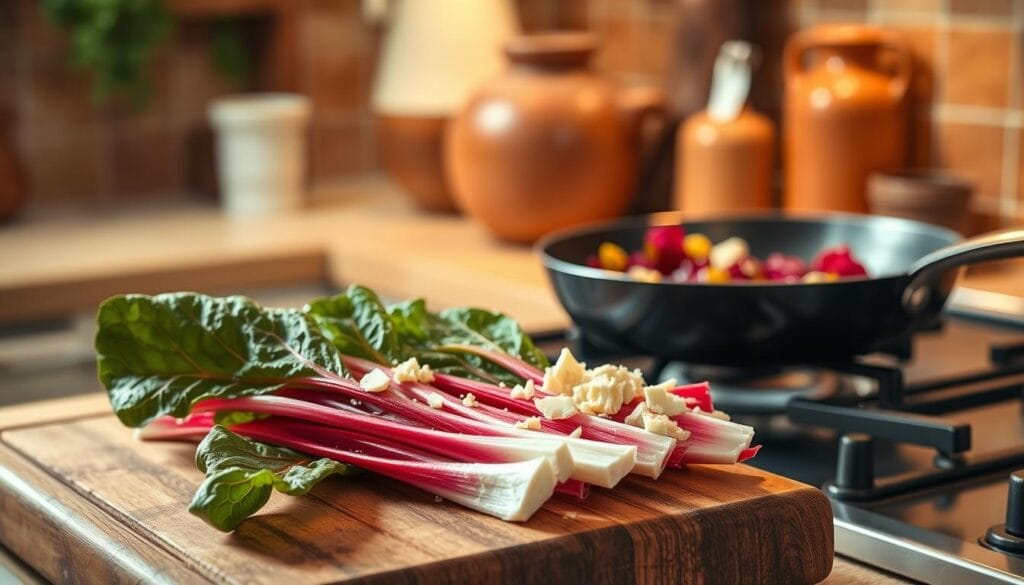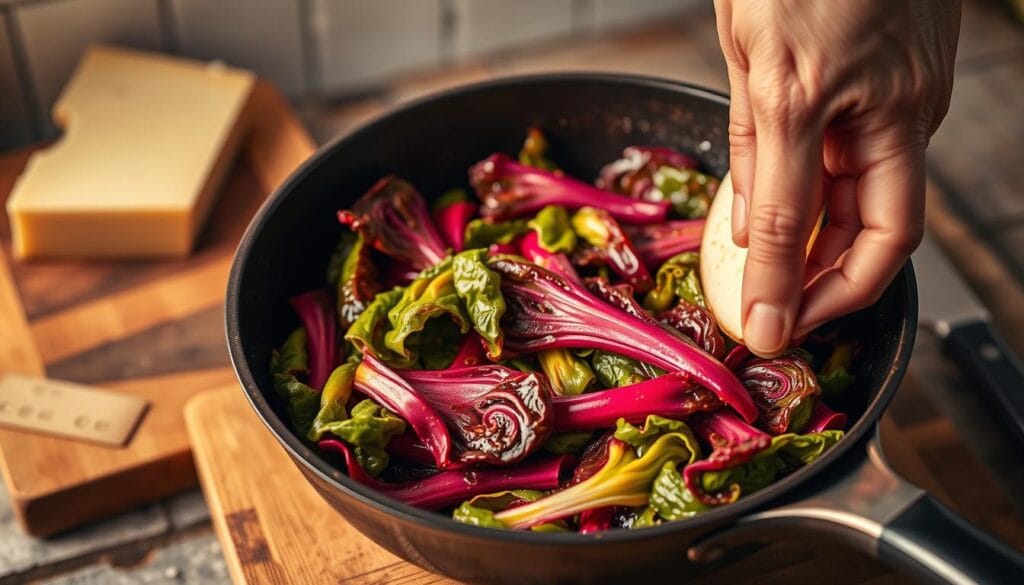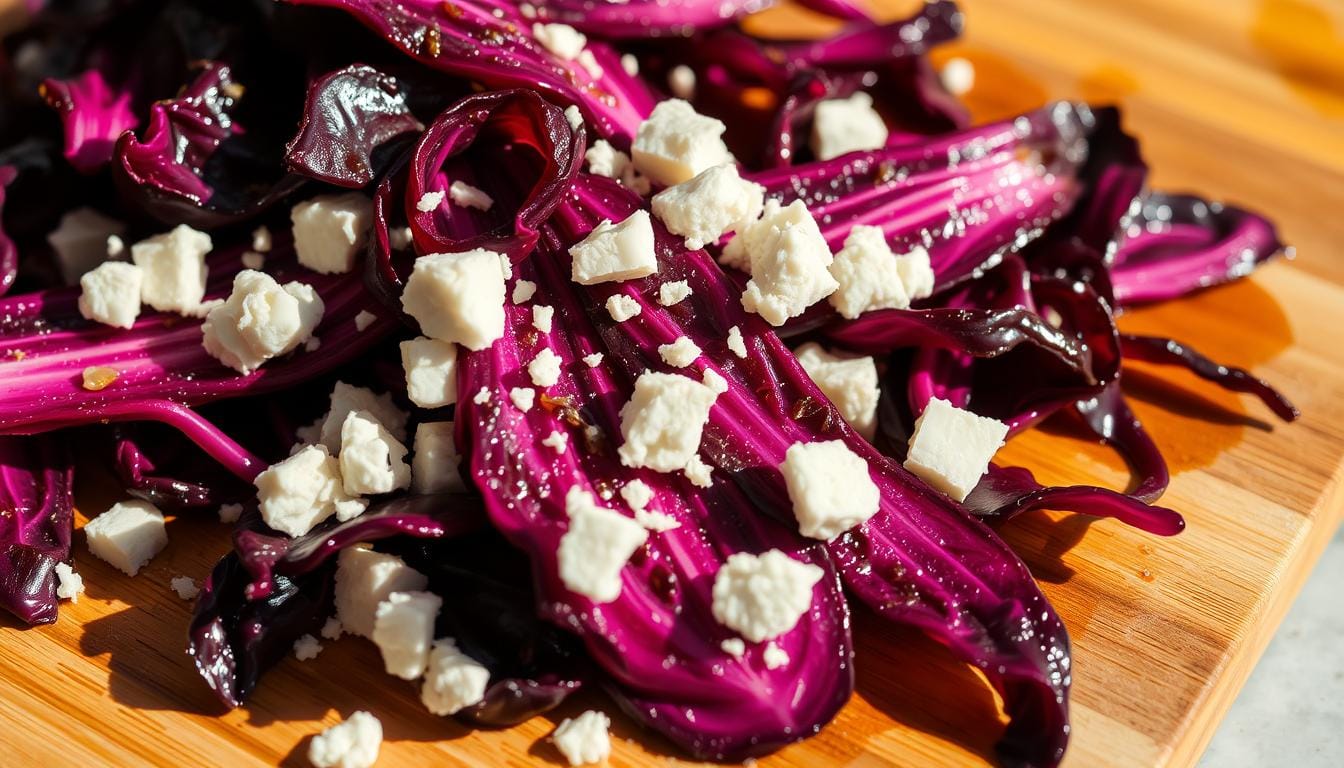Radicchio Sautéed with Pecorino Sardo Cheese: A Refined Accompaniment and Intense Flavors of Italy
Imagine a dish that captures the heart of Italian cuisine. It combines the slightly bitter radicchio with the sharpness of Sardinian cheese. This is Radicchio sautéed with Pecorino Sardo, a dish that makes any meal special.
This dish pairs radicchio, a key ingredient in Italian cooking, with Pecorino Sardo, a cheese with a rich taste. Together, they offer a true taste of Italy.
Table of Contents
Key Takeaways
- Discover the unique flavors of radicchio and Pecorino Sardo cheese.
- Learn how to combine these ingredients for a refined accompaniment.
- Explore the cultural significance of this dish in Italian cuisine.
- Understand the simplicity of preparing this sophisticated dish.
- Appreciate the rich culinary tradition behind radicchio and Pecorino Sardo.
Introduction to Radicchio and Pecorino Sardo
In Italian cooking, radicchio and Pecorino Sardo are stars. They bring unique tastes and textures to dishes. These ingredients make Italian food truly special.
What is Radicchio?
Radicchio is a chicory with a bright red color and a bitter taste. It’s great in salads, pasta, and as a side dish. When cooking it, balance its bitterness with other flavors.
Here are some ways to use radicchio in your cooking:
- Add it to salads for a burst of color and flavor.
- Sauté it with garlic as a side dish.
- Use it in pasta recipes to add depth.
The Unique Taste of Pecorino Sardo
Pecorino Sardo is a cheese from Sardinia, made from sheep’s milk. It has a sharp, salty taste. This cheese pairs well with radicchio, making a great flavor mix.
Here’s a comparison of radicchio with other leafy greens in Italian cooking:
| Leafy Green | Flavor Profile | Best Used In |
|---|---|---|
| Radicchio | Bitter, slightly sweet | Salads, sautéed dishes |
| Spinach | Mild, earthy | Pasta, salads, smoothies |
| Kale | Earthy, slightly bitter | Soups, salads, sautéed dishes |
Knowing radicchio and Pecorino Sardo’s unique qualities is crucial for making tasty Italian dishes. By using these ingredients, you can make your meals more flavorful and explore Italy’s rich culinary heritage.
The Origins of Radicchio
Radicchio’s roots are deeply connected to Italian history and food. It dates back to ancient times, when the Romans valued it for its taste and health benefits.
Historical Background
Radicchio has been a key part of Italian food for centuries, especially in the Veneto region. It has a special place in Treviso, where it’s grown today. The area’s climate and soil make radicchio taste and feel unique.
Historically, radicchio was a luxury food, enjoyed at special events. Its fame grew, and it became a common ingredient in many dishes.
Varieties of Radicchio
There are many radicchio types, each with its own look and taste. Radicchio di Chioggia is known for its round shape and bright red color. Radicchio di Treviso is longer and sweeter.
- Radicchio di Chioggia: Known for its round shape and deep red color, this variety is great for salads and sautéing.
- Radicchio di Treviso: This variety has a more delicate flavor and is often used in high-end Italian cuisine.
- Radicchio di Verona: Similar to Chioggia but with a slightly different taste profile, it’s also popular for its crunchy texture.
These varieties look and taste different, making them perfect for various dishes.
The Story Behind Pecorino Sardo
Pecorino Sardo is more than a cheese; it’s a symbol of Sardinia’s rich culture and cheese-making traditions. This cheese has been made for centuries, with methods passed down through generations.
Sardinia’s Cheese-Making Tradition
Sardinia’s unique culture and geography have shaped its cheese-making. Pecorino Sardo is made from sheep’s milk, from the island’s native breeds. It’s known for its rich, tangy flavor, developed during aging.
The making of Pecorino Sardo is deeply rooted in Sardinian culture. It’s often made in small, family-run dairies, where traditional methods are used. This ensures quality and preserves the region’s cultural heritage.
Differences Among Pecorino Varieties
While Pecorino Sardo shares traits with other Pecorinos, like Pecorino Romano, it has its own taste and methods. Pecorino Sardo is aged for a shorter time, making it milder.
The differences in Pecorino varieties come from their production regions and techniques. For example, Pecorino Sardo is from Sardinia, while Pecorino Romano is from Lazio. Knowing these differences helps you enjoy each cheese’s unique qualities.
Pairing Pecorino Sardo with radicchio, like in a radicchio salad or sautéed radicchio, is perfect. The cheese’s rich flavor balances the radicchio’s bitterness, offering a refined taste experience.
Nutritional Benefits of Radicchio
Radicchio is not just tasty; it’s also packed with nutrients. When you try out radicchio recipes, knowing its health benefits adds to the fun.
Vitamins and Minerals
Radicchio is full of vitamins and minerals. It’s especially rich in vitamins A, C, and K. These vitamins are good for your eyes, immune system, and blood clotting.
It also has potassium and manganese. Potassium helps control blood pressure and supports muscles. Manganese is an antioxidant that helps with enzyme functions.
Health Benefits
Radicchio offers many health benefits. Its antioxidants protect cells from damage. This can lower the risk of heart disease and cancer.
The fiber in radicchio is great for your digestive health. It helps with regular bowel movements and can help you feel full longer. This can aid in weight management.
| Nutrient | Amount per 100g | Health Benefit |
|---|---|---|
| Vitamin A | 10% DV | Supports healthy vision and immune function |
| Vitamin C | 20% DV | Essential for collagen production and iron absorption |
| Vitamin K | 25% DV | Crucial for blood clotting and bone health |
| Potassium | 8% DV | Regulates blood pressure and supports muscle function |
| Manganese | 10% DV | Involved in enzyme systems and acts as an antioxidant |
Adding radicchio to your meals is a tasty way to get more nutrients. It’s a great choice for boosting your health or trying new flavors.
Why Pair Radicchio with Pecorino?
In Sardinian recipes, radicchio and Pecorino Sardo are a standout duo. Their pairing is more than just taste; it’s a culinary experience that highlights Italian cuisine’s best.
Flavor Profile Harmony
Radicchio’s bitterness perfectly balances Pecorino Sardo’s salty, umami taste. Together, they offer a complex yet refined flavor. The secret to this harmony is their contrast. The bitterness of radicchio balances the richness of the cheese, creating a perfect flavor balance.
To grasp this harmony, let’s look at their flavors:
| Ingredient | Primary Flavor | Secondary Flavor |
|---|---|---|
| Radicchio | Bitter | Slightly sweet |
| Pecorino Sardo | Salty | Umami |
Complementing Textures
The textures of radicchio and Pecorino Sardo also complement each other. Sautéed radicchio’s crunch pairs well with grated Pecorino Sardo, adding depth. This contrast makes each bite more engaging.
Pairing radicchio and Pecorino Sardo creates a dish that’s both flavorful and textured. This shows the versatility and richness of Italian cuisine, especially in Sardinian recipes.
Cooking Methods for Radicchio

To get the most out of radicchio, pick the right cooking method. Radicchio’s taste and texture can be improved with different cooking ways. This makes it a great ingredient in many dishes.
Sautéing Techniques
Sautéing is a favorite way to cook radicchio. It cooks the veggie fast while keeping its texture. Start by heating olive oil in a pan over medium heat. Add minced garlic for extra taste, then add the radicchio. Stir often until it’s cooked to your liking.
Tips for Sautéing Radicchio:
- Use high-quality olive oil for the best flavor.
- Don’t overcrowd the pan to ensure even cooking.
- Add a squeeze of lemon juice to enhance the flavor.
Other Cooking Options
Radicchio can also be grilled, braised, or roasted. Grilling adds a smoky taste, braising makes it tender, and roasting brings out its sweetness.
| Cooking Method | Description | Best For |
|---|---|---|
| Sautéing | Quickly cooking radicchio in a pan with oil or butter. | Preserving texture and flavor. |
| Grilling | Cooking radicchio over direct heat to add a smoky flavor. | Adding a charred taste to dishes. |
| Braising | Cooking radicchio in liquid over low heat for a long period. | Making radicchio tender and rich. |
Try different cooking methods to find your favorite radicchio way. Whether you sauté, grill, or braise it, radicchio will make your meals delicious.
Sautéed Radicchio Recipe with Pecorino Sardo
To taste Italy’s true essence, try sautéing radicchio with Pecorino Sardo. This dish combines radicchio’s slight bitterness with Pecorino Sardo’s sharp, salty taste. It’s a perfect blend of Italian flavors.
Ingredients Needed
Here’s what you need for this tasty radicchio recipe:
- 1 head of radicchio, cleaned and chopped
- 2 cloves of garlic, minced
- 1/4 cup of extra virgin olive oil
- 1/2 cup of Pecorino Sardo cheese, grated
- Salt and pepper to taste
Step-by-Step Preparation
Follow these steps to make your sautéed radicchio with Pecorino Sardo:
- Heat the olive oil in a large skillet over medium heat.
- Add the minced garlic and sauté until fragrant, about 1 minute.
- Add the chopped radicchio to the skillet, stirring to coat with the garlic and olive oil.
- Cook the radicchio until it’s slightly wilted, about 3-4 minutes.
- Season with salt and pepper to taste.
- Remove from heat and sprinkle with grated Pecorino Sardo cheese.
- Serve immediately, enjoying the harmony of flavors.
Radicchio and Pecorino Sardo are a classic Italian duo. They offer a delightful contrast of textures and flavors. The radicchio’s slight bitterness pairs well with the sharp, salty Pecorino Sardo. This makes for a dish that’s both simple and sophisticated.
| Ingredient | Quantity | Purpose |
|---|---|---|
| Radicchio | 1 head | Main ingredient, providing a slightly bitter taste |
| Garlic | 2 cloves | Adds depth and aroma to the dish |
| Olive Oil | 1/4 cup | Used for sautéing, adds richness |
| Pecorino Sardo | 1/2 cup, grated | Provides a sharp, salty flavor |
Perfect Pairings for Radicchio and Pecorino
Pairing radicchio and Pecorino Sardo with the right wine and serving suggestions can make your meal better. Radicchio’s bitterness and Pecorino’s saltiness are balanced well with the right choices.
Wine Pairings
Choosing the right wine can make radicchio and Pecorino Sardo taste even better. Dry white wines like Pinot Grigio go well with radicchio’s bitterness. Light reds, such as Valpolicella, match Pecorino’s richness.
For a true Italian taste, try a Vermentino or a Chianti. These wines have the right acidity and structure for the bold flavors. You can also try Sparkling wines for a special touch. A dry Prosecco is refreshing and great for a light meal or appetizer.
Serving Suggestions
Radicchio and Pecorino Sardo can be served in many ways. A Radicchio salad with other greens, nuts, and a light vinaigrette is popular. The bitterness of radicchio and the nuttiness of Pecorino make a great mix.
Sautéed radicchio as a side dish or in an antipasto platter is another good idea. The char from sautéing adds flavor that goes well with Pecorino Romano. Radicchio and Pecorino also add depth to pasta dishes or risottos.
For a simple yet elegant appetizer, try radicchio, Pecorino, and olive oil on toasted bread. This dish showcases the flavors of both ingredients and is a great start to any meal.
Common Mistakes When Cooking Radicchio

Radicchio is a favorite in Italian cooking, but it can be tricky for beginners. One big mistake is overcooking, which makes it taste bitter.
Overcooking Tips
To prevent overcooking radicchio, watch its cooking time carefully. Sautéing is fast, but radicchio can burn quickly.
Tips for Perfect Sautéing:
- Use high heat to quickly wilt the leaves.
- Stir constantly to prevent burning.
- Cook until it’s just tender, still retaining some crispness.
Flavor Enhancements
To make radicchio taste better, balance its bitterness with other flavors. Garlic and lemon are great for this.
Simple Flavor Enhancers:
| Ingredient | Purpose |
|---|---|
| Garlic | Adds a pungent flavor that complements radicchio’s bitterness. |
| Lemon Juice | Provides acidity that cuts through the richness of radicchio. |
| Olive Oil | Used for sautéing, it adds a smooth, rich texture. |
By avoiding common mistakes and using the right flavor enhancements, you can create delicious radicchio dishes that showcase its unique qualities.
Variations on Sautéed Radicchio
Radicchio is a versatile ingredient that goes well with many foods. It’s easy to make different dishes with it. You can add various ingredients to the basic recipe to match your taste.
Adding Other Ingredients
To make sautéed radicchio even tastier, try adding cherry tomatoes, garlic, or anchovies. These not only add flavor but also make your meal healthier.
- Cherry Tomatoes: Halve or quarter cherry tomatoes and sauté them with radicchio for a burst of sweetness.
- Anchovies: Mince anchovies and mix them into the radicchio for a salty, umami flavor.
- Garlic: Sauté minced garlic before adding radicchio to create a flavorful base.
Unique Serving Ideas
Sautéed radicchio can be served in many ways. It’s great as a topping for bruschetta, a side for grilled meats, or a filling for sandwiches.
- Bruschetta Topping: Top toasted bread with sautéed radicchio, a sprinkle of Pecorino Sardo, and a drizzle of olive oil.
- Grilled Meats: Serve sautéed radicchio alongside grilled meats like steak or chicken for a well-rounded meal.
- Sandwich Filling: Use sautéed radicchio as a filling in sandwiches, adding a layer of flavor and nutrition.
By trying different ingredients and serving ideas, you can enjoy sautéed radicchio in many Sardinian-inspired dishes.
The Role of Radicchio in Italian Cuisine
Italian cuisine loves radicchio, using it in both old and new recipes. Its special taste and feel make it great for many dishes.
Traditional Dishes
Radicchio has been a key part of Italian food for ages. It’s in salads, sautéed mixes, and on top of Italian favorites. Its bitter taste enriches these dishes, making it a favorite.
Some traditional uses include:
- Adding radicchio to salads for a burst of color and flavor
- Sautéing radicchio with garlic and olive oil as a side dish
- Incorporating radicchio into risottos and pasta dishes for added texture
Contemporary Interpretations
Modern Italian cooking keeps getting creative with radicchio. Chefs are trying new things, like radicchio and pear salads and sautéed radicchio with prosciutto.
| Dish | Description | Key Ingredients |
|---|---|---|
| Radicchio Salad | A refreshing mix of radicchio, arugula, and citrus | Radicchio, arugula, citrus segments |
| Sautéed Radicchio | A simple yet flavorful side dish | Radicchio, olive oil, garlic |
| Radicchio Risotto | Creamy risotto with the bitterness of radicchio | Radicchio, Arborio rice, Parmesan cheese |
Learning how to cook radicchio opens up many culinary doors. Whether you’re making a classic dish or trying something new, radicchio brings a special touch.
Conclusion: Enjoying the Flavors of Italy
Exploring Italian cuisine, you’ll find dishes like radicchio sautéed with Sardinian pecorino. They show Italy’s focus on quality and simple, tasty cooking. This mix captures the heart of Italian food culture.
By diving into Italian cooking traditions, you open up to new tastes and ingredients. Start by adding radicchio and Pecorino Sardo to your meals. See how they enhance different dishes with their rich flavors.
Culinary Exploration
Italian food is full of tasty dishes, from pasta classics to veggie meals. Trying new ingredients and methods will grow your love for Italy’s culinary history.
Discovering New Flavors
Keep exploring Italian food by trying different radicchio types and pairing them with Sardinian pecorino. This way, you’ll get to know Italy’s full flavor range and make unforgettable meals.

